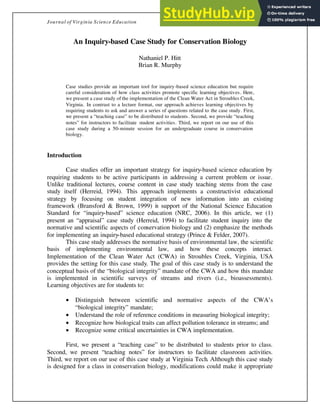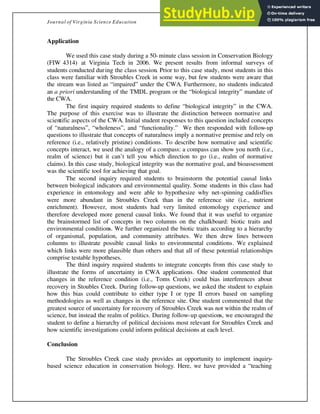The document presents a case study for using Stroubles Creek, Virginia to teach students about the Clean Water Act and conservation biology. It provides background on the Act, describes how the creek was deemed impaired, and outlines the total maximum daily load study conducted. It then provides the case materials and teaching notes to structure classroom activities around discussing key concepts like the scientific and normative aspects of the Act, and recognizing uncertainties in its implementation. The goal is for students to actively engage with the real-world example to further their understanding of these topics.



![Journal of Virginia Science Education Volum e 2, Num ber 1
not consider the spatial configuration of land uses (i.e., proximity to streams) but instead
averages land uses upstream of analysis areas.
Public meetings, field trips, and working groups were used to develop an
Implementation Plan for the TMDL. The TMDL Implementation Plan aims for a 77%
reduction in agricultural sediment inputs and a 54% reduction from urban sources
(Yagow, et al., 2003). Specific objectives of the TMDL Implementation Plan involve
Best Management Practices for the agricultural areas and storm water reductions for the
urbanized areas (Benham, et al., 2003; Yagow, et al., 2003). Successful restoration of the
stream (and delisting from the CWA) will require the cooperation of many stakeholders,
including landowners, Virginia Tech, the town of Blacksburg, and natural resource
agencies. Although the TMDL establishes a legal limit for pollution in Stroubles Creek,
landowner implementation of the TMDL is voluntary. As such, it remains to be seen
whether or not the current implementation of the CWA will be successful in restoring the
stream.
Teaching notes
Class activities
Students should read the “teaching case” prior to class. In class, the instructor
should first introduce the case study by explaining the importance of the CWA and the
specific learning objectives for the class session (see USEPA [2007] for an introduction
to the CWA). Following the discussion format of Herreid (1994), we recommend a series
of rapid brainstorming exercises to help students achieve the learning objectives listed
above. For each exercise, we provide specific objectives for class discussion and
recommend time allocations for using this case study in a 50-minute class session.
Question #1: What is “biological integrity?”
When asked to define integrity, students may invoke concepts of health, stability,
naturalness, wholeness, functionality, and diversity. The instructor should ask follow-up
questions to demonstrate that (a) naturalness is a normative concept, (b) organisms can be
“healthy” whereas ecosystems cannot, (c) stability can be non-natural in some cases (e.g.,
dams reducing downstream flow variability), and (d) assessing “integrity” requires a
standard for comparison(i.e., reference conditions). For example, the instructor may wish
to ask students “what is pollution?” to illustrate that their established notions of
“pollution” invoke a normative basis of naturalness and require a baseline for
comparison.
The primary objective for this brainstorming exercise is to illustrate that the
CWA’s biological integrity mandate includes normative concepts (i.e., integrity is good)
as well as scientific concepts (i.e., role of reference conditions) (Policansky, 1998). The
reference site concept leads into the next brainstorming exercise. The desired outcome of
this exercise is for students to identify their own questions related to the concept of
reference conditions in assessing environmental quality (e.g., “how does Stroubles Creek
compare to reference conditions?”). For a 50-minute class, this exercise and discussion
should take approximately 15 minutes.](https://image.slidesharecdn.com/aninquiry-basedcasestudyforconservationbiology-230805215736-2ec6ea1f/85/An-Inquiry-Based-Case-Study-For-Conservation-Biology-4-320.jpg)



